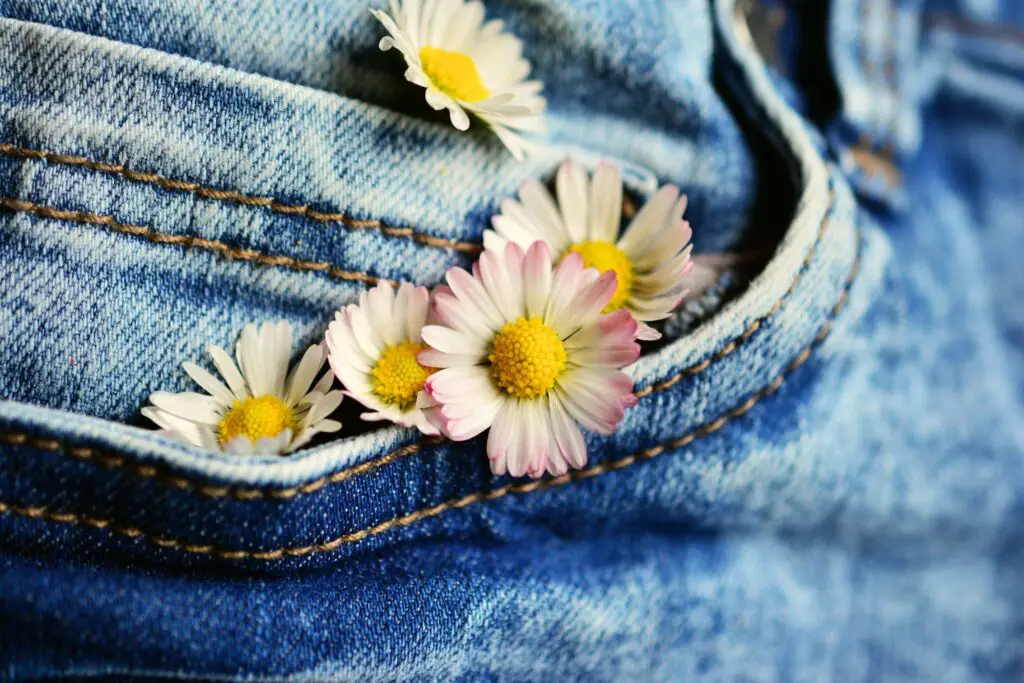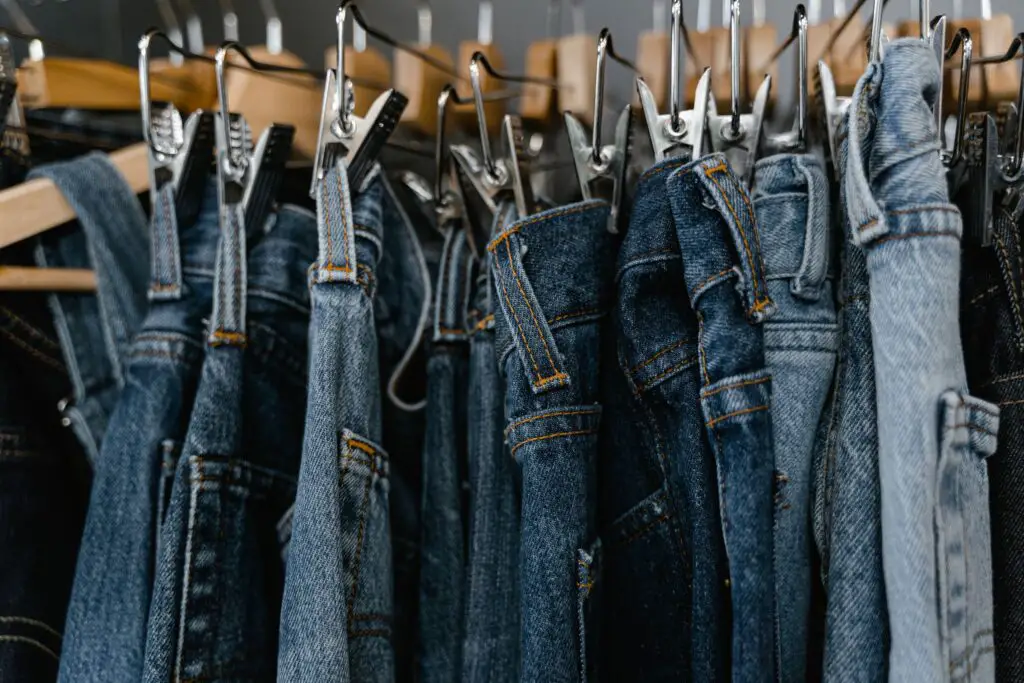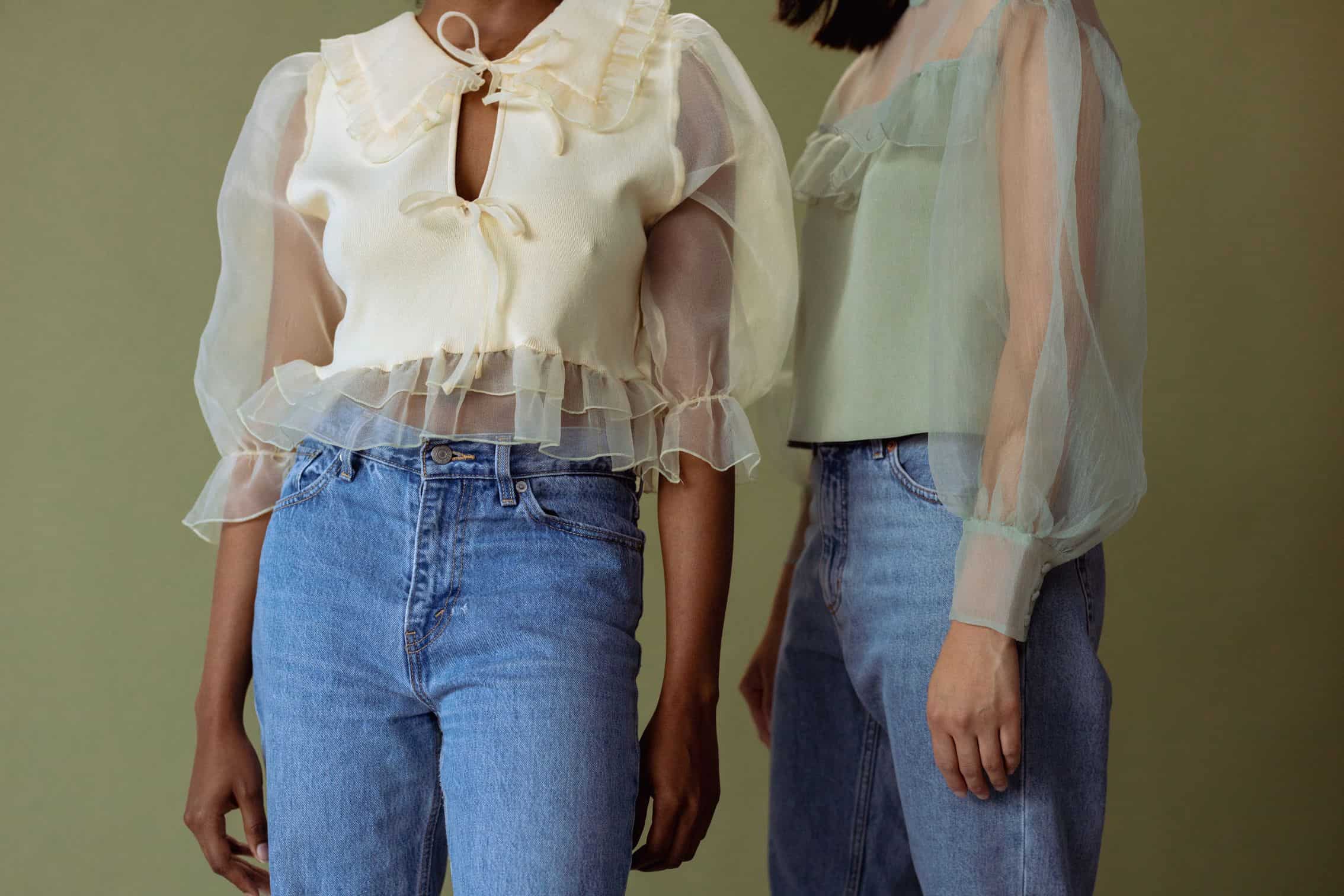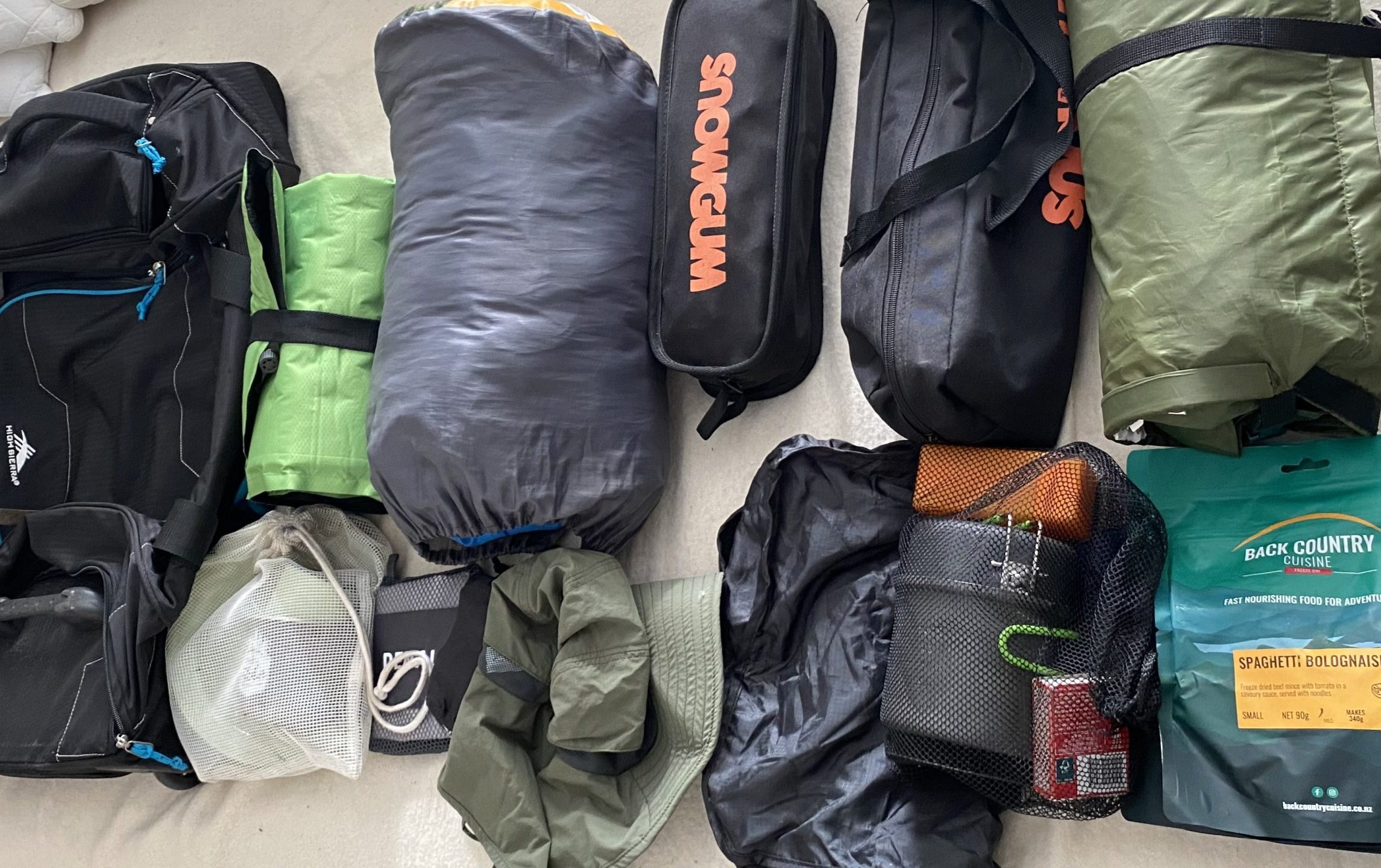Do Eco-Friendly Jeans Exist?
What to Look Out For

This post was last updated in 2024
Hello there my eco-conscious warriors 😊
Are you on the hunt for the perfect pair of jeans that are not only stylish but also kind to our planet? Look no further! I’ve put together a comprehensive guide to help you understand what you need to look out for when shopping for an eco-friendly pair of jeans.
Jean can be eco-friendly jeans as long as you consider these aspects – the material the jeans are made from, the dying process used, the finishing process used to get the different wash colours, the end-of-life considerations and the overall ethos of the company.
In doing my research I was surprised to discover that there was a 153% increase in online searches for “sustainable jeans” between 2020 and 2022. And the unfortunate thing is – people can be led astray by greenwashing.
Marketers can use green labels and buzzwords like “natural, “sustainable” and “recycled” without substantiating their claims. This makes it difficult for us as consumers to work out which brands are exploiting eco-friendly trends and who are genuinely committed to sustainability.
So it’s important to be fully informed and know what to look out for and this blog post will help you with this. Specifically I cover:
If you are not interested in this information and you are just after a list of brands that sell sustainable jeans, then check out this blog post: Sustainable Jeans Available in Australia – Options to Suit All. There you will find a full list of brands that are doing their part to produce sustainably made products, covering varying styles and price ranges so you should be able to find something that suits you.
But it is important to know what to look out for, so you can be an informed, conscious consumer. So keep reading on to learn more about what qualities jeans need to have to be considered eco-friendly.
Let’s get into it 🚀
Eco-friendly jeans and how to spot them
Traditional methods of producing jeans can be so resource intensive and extremely harmful to the environment so there a lot of room for improvement in the industry!
There are measures companies can take to ensure the jeans they produce have minimal impact as possible on the environment and the list below outlines these measures, giving you some guidance on what you should look out for when buying your next pair of jeans.
1. Materials and Water Usage: Choose Wisely
Did you know that conventional cotton, the main fibre in denim, is incredibly water-intensive? Estimates suggest it takes between 1,800 to 7,600 gallons of water to make just one pair of jeans! Plus, conventional cotton is often genetically modified and requires harmful pesticides and fertilizers to produce the amounts the market demands.
Solutions: Opt for jeans made from organic or regenerative cotton. These rely on much, much water.
Also, look for eco-friendly fabrics like hemp or Tencel. Better still choose denim that includes recycled materials, which helps reduce the reliance on virgin resources
But be aware: Some brands misuse the terms “sustainable”, “natural”, “biodegradable” and “recycled” by setting low bars or vague standards for recycled content*. Ideally, jeans should be made from at least 95% organic or at least 40% recycled*.

Certifications like GOTS (Global Organic Textile Standard), Better Cotton Initiative (BCI) and (Organic Content Standards) OCS are good indicators of sustainable practices. Look out for jeans that meet GRS (Global Recycling Standards) if the brand is claiming jeans are made from recycled materials.
Bluesign, Jeans Redesign Project and C2C (cradle to cradle) are some other certifications you may come across but they are known to be problematic so don’t rely on these alone.
* Note this from the Ethical Consumer guide: Some brands have a much lower bar for what ‘sustainable’ means, for example, Wrangler defines cotton as ‘sustainable’ as long as it’s grown in the US, Africa, or Australia. Brands might also describe jeans as ‘recycled’ without specifying percentages. Boohoo for example was selling ‘petite recycled high waist skinny jeans’ but provided no information about how much of the material is actually recycled. Not great.
2. Dying and Chemical Use: Go Natural
Denim is traditionally dyed blue using natural indigo. Indigo sticks to the surface of cotton, creating characteristic fades. However, most brands now use synthetic indigo due to cost and availability.
Synthetic indigo is commonly in powder form and needs reduction agents like sodium dithionite to dissolve in water. It also contains toxic chemicals like formaldehyde, which can pollute water sources and harm marine life when washed into waterways. Pollution from dyeing processes has been reported globally, notably in Bangladesh and Lesotho.
Solutions: Choose jeans dyed with natural plant or mineral dyes, or no dyes at all (rare!).
3. Finishing Process and Water Usage: Less is More
Creating the perfect “wash” in jeans can waste up to 80 litres of water per pair. This process also introduces chemicals and dyes into waterways. Other traditional methods involve using pumice stones or sandpaper, generating waste and damaging jeans. Not to mention how damaging this method is to workers. But chemical washes are the worst, also known for being dangerous for both workers and the environment.
Solutions: Look for brands using innovative technologies to reduce water, energy, and chemical usage. Laser distressing is a great eco-friendly alternative that can create designs and details without wasting water or using harmful chemicals. You could even consider DIY distressing or buying from ethical handcrafters (check out Esty)!

4. Traceability: Know the Journey of Your Jeans
One of the biggest challenges in the denim industry is the lack of transparency in supply chains. Low wages and unsafe working conditions are unfortunately common.
What has this got to do with sustainability? Lack of transparency in supply chains is not only an ethical issue, it is an environmental one as openness helps us to assess environmental impacts.
Solutions: Ensure the brand provides clear information about the origin, production process and supply chain of their garments. Brands that are transparent about where and how their garments are made are usually more committed to fair wages and safe working conditions, as well as ensuring garments are made with minimal impact on the environment.
5. Circularity: Think Beyond the Wear
The fashion industry produces massive amounts of waste, with many jeans ending up in landfills, contributing to pollution and microplastics. To help combat this, the brands that sell you your jeans should provide end-of-life options, so you know what to do with your jeans once you’re done with them.
Solutions: Look out for brands that have repair or take-back upcycling or recycling programs to give your jeans a second life.
6. Climate Actions: Support the Right Brands
Not all brands are equal when it comes to their climate policies. Some are leading the way with strong climate actions and targets. Unfortunately, many large brands are falling short.
Solutions: Prefer brands with strong, transparent climate policies. By supporting companies committed to reducing their environmental impact, you can help drive change in the industry. Check resources like the Fashion Transparency Index or Good On You app to see how your favourite brands measure up.
These are the key elements that make up an eco-friendly jeans brand.
Extra tips to consume consciously
But what else can you do when you need a new pair of jeans, to make sure you are a conscious consumer? Well here are some tips:
Proper care: Proper care can significantly extend the life of your denim. Airing between wears, spot cleaning, and washing on a cold delicate cycle can preserve both the fabric and its environmental footprint.
Buy Less, Buy Better: Invest in fewer, higher-quality pieces that will last longer. Classic, versatile styles can be worn for many years.
Rent or Buy Vintage: You don’t have to buy new. Renting denim or buying vintage are great ways to reduce the demand for new resources and lower your environmental impact.

Checklist when shopping for eco-friendly jeans
To summarise all this information is a short, snappy checklist here’s what to look out for:
1. Materials & Water Usage: Opt for jeans made from organic or regenerative cotton and eco-friendly fabrics like hemp and Tencel.
2. Dyeing & Chemical Use: Choose jeans dyed with natural dyes or no dyes at all
3. Finishing Process & Water Usage: Look for brands that use water-saving and chemical-free finishing techniques, such as lasers.
4. Traceability: Ensure the brand is transparent about its supply chain and labour practices.
5. Circularity: Support brands offering repair, recycling or upcycling programs for their jeans.
6. Climate Action: Prefer brands with strong, transparent climate policies and commitments.
No company is going to tick all the boxes but there are quite a few that tick multiple boxes here. My favourite at the moment is Nudie Jeans. They are quality products that will last and they look great too. You can check them out through this affiliate link: Nudie Jean.
I did not appreciate how complex and environmentally demanding making a simple pair of jeans can be. Traditional methods require significant energy, water, carbon emissions and labour during both fabric production and laundering/finishing stages. But it’s good to know that there are ways to minimise these impacts.
So I hope this guide helps you make more eco-friendly choices on your next denim shopping spree.
If you have any tips or favourite sustainable brands, share them in the comments below.
If you have not come across any such brands and need some guidance, check out this blog post: Sustainable Jeans Available in Australia – Options to Suit All
Let’s inspire each other to live more sustainably because it is through these conscious choices, we can collectively work towards a more sustainable future 🌎
xxx Tahsin
A Heads Up: This post may contain affiliate links that earn me a small commission at no additional cost to you. Also as an Amazon Associate, I earn from qualifying purchases. I only recommend products and services that will help you take steps towards a more sustainable life and will not recommend anything that does not align, in some way, with these values.
References:
Here’s a list of reference material that informed the content for this blog post:
- https://goodonyou.eco/ultimate-guide-to-sustainable-jeans-and-ethical-denim/
- https://www.ethicalconsumer.org/fashion-clothing/shopping-guide/ethical-jeans
- https://www.marieclaire.com/fashion/sustainable-denim/
- https://www.prettygreenlily.com/guide-to-sustainable-jeans-denim-brands/




